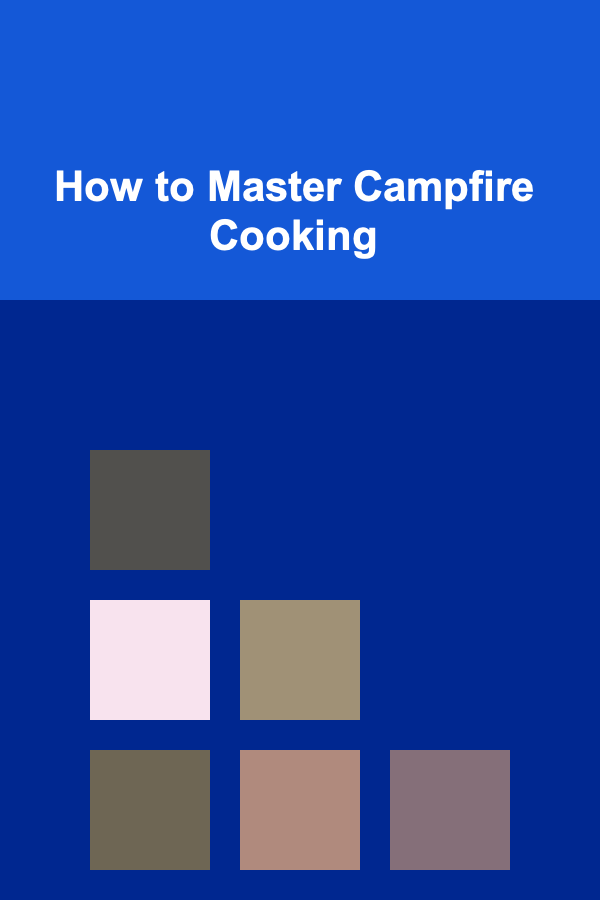
How to Master Campfire Cooking
ebook include PDF & Audio bundle (Micro Guide)
$12.99$6.99
Limited Time Offer! Order within the next:

Campfire cooking has been a tradition for centuries, bringing together nature, creativity, and the joy of preparing meals outdoors. Whether you are a seasoned camper or a beginner, knowing how to master campfire cooking can elevate your outdoor experience. Not only does it allow you to enjoy delicious meals surrounded by nature, but it also enhances your connection to the environment and the art of simple cooking.
In this article, we will explore the essentials of campfire cooking, from the tools and techniques to the best recipes and safety tips. This comprehensive guide will help you transform your campfire cooking experience, whether you're preparing a basic meal or a gourmet feast under the stars.
Understanding Campfire Cooking Basics
Before diving into the actual cooking process, it's important to understand some key aspects of campfire cooking. The campfire is your cooking surface, and the type of fire you build plays a crucial role in the cooking process. The heat from the fire can be used in different ways to create the perfect cooking environment.
Types of Campfire Fires
To master campfire cooking, you need to understand the different types of fires and how they produce heat. There are three main types of fire you'll encounter in campfire cooking:
- The Campfire for Cooking: This is the classic campfire with flames, which is great for roasting marshmallows or cooking items that need direct heat, such as hot dogs.
- The Ember Bed: This is when the fire has burned down to glowing embers. It provides consistent, even heat, making it ideal for cooking in pots, pans, or foil packets. It's also a great heat source for slow cooking or baking.
- The Indirect Heat Setup: This involves creating a fire that generates heat but without direct flame contact with the food. This setup is often used for cooking larger meals that require longer cooking times, such as stews or roasts.
Understanding Heat Control
Controlling heat is crucial to successful campfire cooking. You should be aware of how heat is transferred from the fire to your food. The key to controlling heat is managing the distance between the food and the flames, adjusting the firewood, and utilizing cooking tools that allow for heat distribution.
- Close to the Flames: When food needs to be cooked quickly, such as searing meat, you'll want to position it closer to the flames. However, keep in mind that food can burn easily if you're too close to the fire.
- Away from the Flames: For slow cooking or simmering, move your pots or pans away from the flames to cook the food over indirect heat.
- Managing Firewood: The size and arrangement of the firewood also affect the cooking temperature. A well-built fire will have layers of burning wood with a steady flow of heat, whereas a poorly arranged fire will burn too hot or too cold, making it hard to cook food properly.
Essential Tools for Campfire Cooking
To master campfire cooking, you'll need a few essential tools that will make cooking easier and more efficient. While you can cook with minimal equipment, having the right gear will expand your options and help you create a wider variety of meals.
1. Cast Iron Cookware
Cast iron skillets, Dutch ovens, and griddles are a must-have for campfire cooking. They retain heat well and provide an even cooking surface. A well-seasoned cast iron pan can be used for frying, sautéing, simmering, and baking.
- Cast Iron Skillets: Perfect for frying, searing, and making one-pan meals.
- Dutch Ovens: Ideal for stews, soups, and slow-cooked meals. Their thick walls allow them to retain heat and distribute it evenly.
- Griddles: Great for pancakes, eggs, and other breakfast dishes.
2. Grill Grates and Tripods
A portable grill grate or tripod can be placed directly over the campfire for cooking. These are ideal for grilling meat, vegetables, and even fish. A tripod with a hanging pot can also be used to cook stews or soups, allowing you to cook your food at a consistent distance from the fire.
3. Campfire Cooking Utensils
Standard kitchen tools can also be used for campfire cooking, but it's beneficial to have some specialized tools designed for outdoor cooking.
- Long-handled Tongs: For flipping and moving food safely without getting too close to the fire.
- Skewers or Roasting Sticks: Perfect for roasting marshmallows, hot dogs, or even vegetables.
- Ladle and Stirring Spoon: Essential for stirring liquids or soups, preventing them from sticking or burning.
4. Heavy-duty Aluminum Foil
Aluminum foil is versatile and can be used to wrap food for cooking in the embers or for creating foil packet meals. Foil packets are an easy way to cook vegetables, meat, and fish by locking in moisture and flavor.
5. Fire Safety Equipment
Safety is paramount when cooking over an open flame. Having fire safety equipment such as a fire extinguisher, shovel, and bucket of water will help ensure that you are prepared in case the fire gets out of control.
Techniques for Cooking Over a Campfire
Now that you have your tools ready, it's time to dive into the various cooking techniques that will help you master campfire cooking. Whether you're cooking over direct flames or using indirect heat, these methods will help you achieve delicious results.
1. Roasting Over Direct Flames
One of the easiest and most fun ways to cook over a campfire is by roasting food over the open flame. This technique works well for foods like hot dogs, marshmallows, and vegetables.
- Roasting Hot Dogs or Sausages: Skewer your hot dogs on a long roasting stick and hold them over the flames, rotating them until they're cooked to your liking.
- Roasting Vegetables: Larger vegetables like corn on the cob, bell peppers, or potatoes can be roasted by placing them directly in the fire, turning them as they cook to achieve an even char.
2. Cooking with a Grill Grate
A grill grate over the campfire is the perfect way to cook meat like steaks, burgers, and chicken. It mimics a traditional barbecue grill and allows you to cook food with direct heat.
- Grilling Meat: Position your grill grate a few inches above the fire and cook meat to your desired level of doneness. Use tongs to flip the meat and rotate it to ensure it cooks evenly on all sides.
- Grilling Vegetables: Brush vegetables like zucchini, eggplant, and mushrooms with oil or seasoning before grilling. Place them directly on the grate and cook, turning occasionally.
3. Cooking in Cast Iron Pots and Pans
Cast iron cookware is versatile for both direct and indirect heat cooking. It retains heat and distributes it evenly, allowing you to cook everything from eggs and bacon to chili and stew.
- Searing Meat: For a perfect sear, heat your cast iron skillet over the flames until it's smoking hot, then add your meat. Allow it to brown before flipping.
- Simmering Soups and Stews: Use a Dutch oven to simmer stews and soups over indirect heat, where the heat from the embers will gently cook the ingredients without burning them.
4. Foil Packet Meals
Foil packets are one of the easiest and most versatile methods for campfire cooking. Wrap your ingredients in aluminum foil and cook them directly in the coals of the fire.
- Recipe Ideas for Foil Packets: Try combinations like potatoes, onions, and sausage or chicken, vegetables, and seasoning. Seal the foil packets tightly to trap the steam inside, cooking the food evenly and locking in flavors.
5. Baking in a Dutch Oven
Dutch ovens are fantastic for baking in the wilderness. With a heavy lid and thick walls, they function like an oven when placed on hot coals.
- Baking Bread and Cakes: Place your Dutch oven on a bed of coals and cover it with more coals on top. This creates an even cooking environment that's perfect for baking bread or cakes.
- Cooking Casseroles and Roasts: Dutch ovens also excel at slow-cooking stews, casseroles, and roasted meats, allowing you to prepare hearty meals while you enjoy the outdoors.
Campfire Cooking Recipes
Now that you know the techniques, it's time to get cooking! Here are some simple yet delicious campfire cooking recipes to try on your next outdoor adventure.
1. Campfire Chili
Ingredients:
- Ground beef or turkey
- Onion, chopped
- Bell peppers, chopped
- Canned beans (black, kidney, or pinto)
- Canned tomatoes
- Chili seasoning (or a mix of cumin, paprika, garlic powder, and cayenne pepper)
Instructions:
- Brown the ground meat in a cast iron pot over the campfire.
- Add onions, bell peppers, and cook until softened.
- Stir in beans, tomatoes, and chili seasoning.
- Simmer over low heat, stirring occasionally, for about 30 minutes.
- Serve hot with your favorite toppings.
2. Grilled Veggie Skewers
Ingredients:
- Zucchini, cut into chunks
- Bell peppers, cut into chunks
- Mushrooms
- Red onion, cut into chunks
- Olive oil, salt, pepper, and herbs
Instructions:
- Thread the vegetables onto skewers.
- Brush with olive oil and sprinkle with salt, pepper, and your choice of herbs.
- Grill the skewers over the campfire, turning occasionally, until the vegetables are tender and slightly charred.
3. Campfire Banana Boats
Ingredients:
- Bananas
- Chocolate chips
- Marshmallows
- Peanut butter
Instructions:
- Slice the banana lengthwise (without peeling it) and create a small pocket.
- Stuff the banana with chocolate chips, marshmallows, and peanut butter.
- Wrap the banana in foil and cook over the campfire for 5-10 minutes until the ingredients melt.
Safety Tips for Campfire Cooking
While campfire cooking is fun and rewarding, it's essential to follow safety guidelines to ensure that you and your fellow campers stay safe.
- Keep a safe distance from the fire: Always maintain a safe distance between yourself and the fire when cooking.
- Use heat-resistant gloves or tools: To avoid burns, always use long-handled tools and heat-resistant gloves when handling hot cookware.
- Extinguish the fire properly: Before leaving your campsite, make sure the fire is completely out. Pour water over the fire, stir the ashes, and add more water until the fire is no longer smoking or hot.
Conclusion
Mastering campfire cooking is a rewarding and enjoyable skill that enhances your outdoor experience. Whether you're roasting marshmallows, grilling steak, or baking bread, the techniques and tools you use can transform a simple campfire into a source of delicious meals. By understanding the fire, using the right equipment, and experimenting with recipes, you can bring the joy of cooking to the great outdoors and create unforgettable memories around the campfire.

How to Choose Affordable Artwork for Your Walls
Read More
How to Collect and Analyze Feedback from Product Testers
Read More
How to Incorporate Holiday Decor Into Your Home Office
Read More
How to Hike in Hot Weather Safely
Read More
How to Learn Basic Robotics for Fun
Read More10 Tips for Automating Your Home Insurance Expense Tracking
Read MoreOther Products

How to Choose Affordable Artwork for Your Walls
Read More
How to Collect and Analyze Feedback from Product Testers
Read More
How to Incorporate Holiday Decor Into Your Home Office
Read More
How to Hike in Hot Weather Safely
Read More